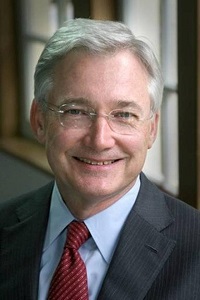BY REV. H. STEPHEN SHOEMAKER
Today is the day we call Good Friday, and on this day we gathered by the old tree standing outside the Old Jail in Statesville. It was here where scaffoldings were erected to hang people in public executions.
 We passed the Old Courthouse in front of which stands the Confederate monument. Early in the 20th century, during the Jim Crow era, more than 1,700 such monuments were erected around the nation, many in front of courthouses. Every Black person who entered these buildings was reminded of the unequal justice in the land. On the Confederate monument in Statesville are the words: “Our cause, though lost, still just.” So it is not just a memorial to those who died in the Civil War, but a defense of the Confederacy. It is a harsh reminder for many of our citizens of slavery’s history and legacy.
We passed the Old Courthouse in front of which stands the Confederate monument. Early in the 20th century, during the Jim Crow era, more than 1,700 such monuments were erected around the nation, many in front of courthouses. Every Black person who entered these buildings was reminded of the unequal justice in the land. On the Confederate monument in Statesville are the words: “Our cause, though lost, still just.” So it is not just a memorial to those who died in the Civil War, but a defense of the Confederacy. It is a harsh reminder for many of our citizens of slavery’s history and legacy.
Many of the people hanged outside the Old Jail were Black persons. In 1878 a Black man was executed for raping a white woman. He was arrested, charged tried and hanged in short order. On the gallows, he exclaimed: “I am innocent of this charge.”
The last public hanging was 25 years later in 1903. The condemned was also a Black man accused of killing a white woman who lived near Cool Springs. His arrest, trial, conviction and hanging happened over a 24-hour period, about the same length of time it took for Jesus’ arrest, trial, conviction and death on the Roman cross. When this man was hanged, raucous crowds gathered in the streets and on the rooftops of nearby buildings to watch. The crowd tore down the curtain that was put up to hide him while he died so they could watch him die.
Of course, lynchings happened too during the Jim Crow era. We have the names of over 6,000 individuals who died by this extra-legal but publicly sanctioned form of execution. Some were women and children. Records show the names of three who were lynched in our county. The local NAACP has been awarded a grant to memorialize these horrid deaths. Throughout the South lynchings were public spectacles, half circus and half revival. Hymns were sung. Parents brought children with picnic baskets. Photos of the hanged were made and sold as souvenirs.
On this day of Crucifixion we must not disconnect the death of Jesus from what Salvadoran martyr Ignacio Ellacuria calls “the crucified peoples of history.” Looking at our own nation’s past, theologian James Cone, in his last book before his death, places the Lynching Tree alongside the Cross. On this day and on this soil the Cross and the Lynching Tree are inextricably entwined. At the Cross, Jesus placed his life alongside the suffering of the innocent and the crucified peoples of the world.
When Jesus was dying on the cross in his public execution, he said words that have changed lives and the life of the world. Praying, he said, “Father, forgive them, for they know not what they do.” That forgiveness has flowed ever since, and to us all, none of us ever knowing the full extent of our wrongs and the harm we have done. It flows anyway, and a forgiveness movement and forgiveness community began that day.
It is this “Father, Forgive,” that redeems this day, and why we can call this day “good.”
Rev. H. Stephen Shoemaker is pastor of Grace Baptist Church in Statesville.




Thanks
Well said. Thanks.
Injustice and suffering committed by people onto other people has been with us forever. Thank you Steve for reminding us that forgiveness is the greatest gift we can receive or give.
Man being inhumane to man has existed forever. That in no way should allow anyone to be comfortable with their own inhumanity. We are commanded to do better when we have learned better.
Will the memorial being developed by the NAACP be in as a highly notable public space as the Confederate memorial located in front of the old courthouse?
Will the Green Street CEMETARY HAVE NOTABLE public SPACE? Many of us from the COMMUNITY WOULD love to see this Happen. NAACP